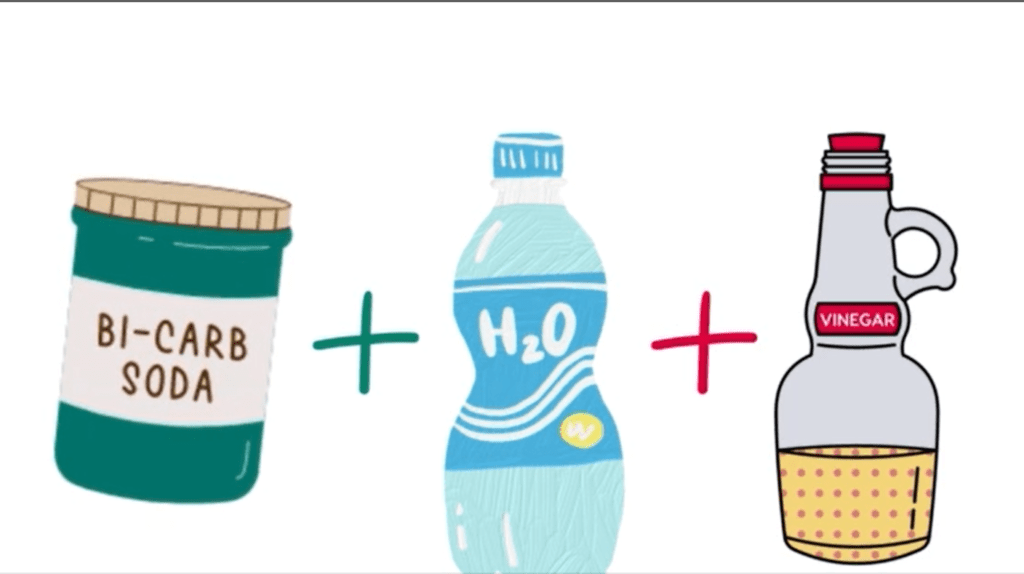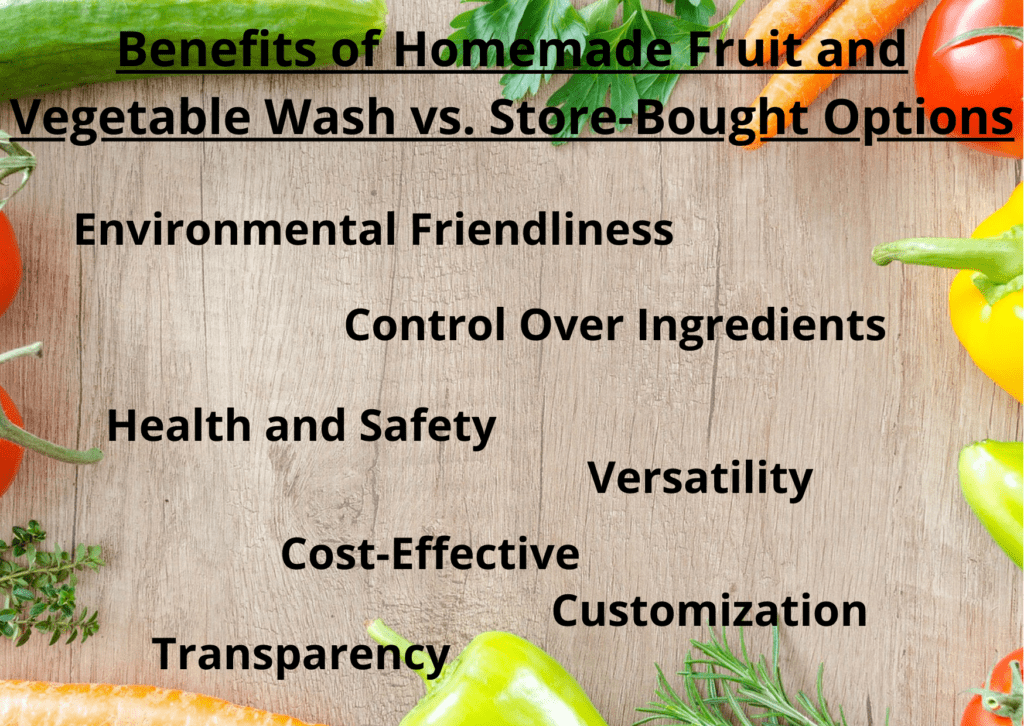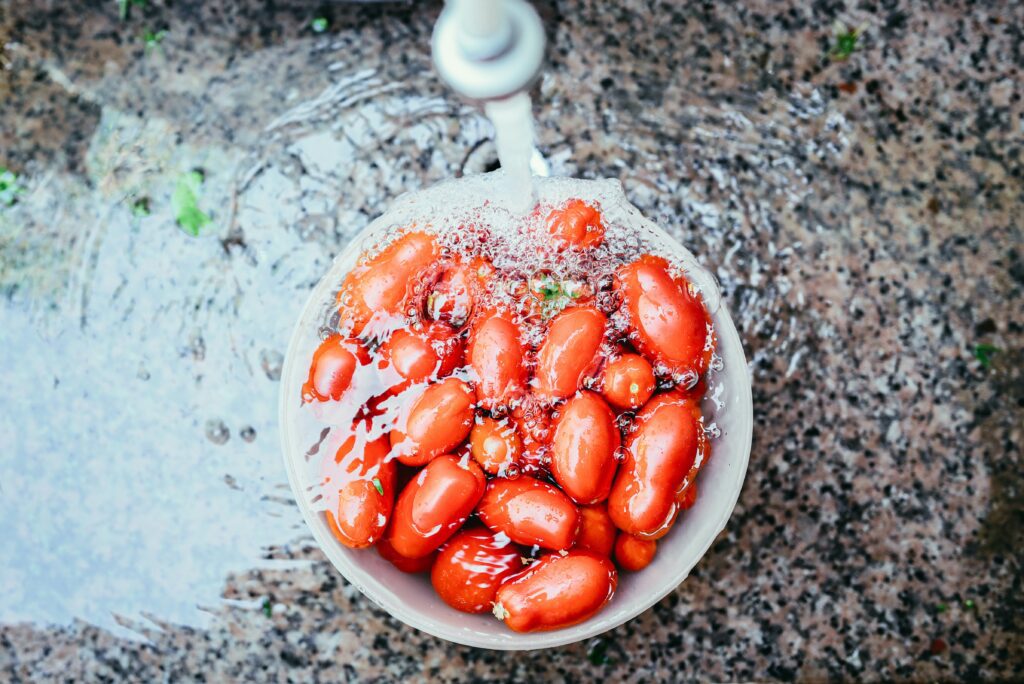Pesticide residues, dirt, bacteria, and other contaminants can cling to the surface of your fruits and veggies, potentially posing health concerns. The good news is that you don’t need to rely on store-bought produce washes laden with chemicals to ensure your produce is clean and safe to eat. In this guide, we will explore a simple, eco-friendly, and health-safe solution: making your own Fruit and Vegetable Wash.
Why Make Your Own Fruit & Vegetable Wash?
By crafting your own produce wash, you can take control of what goes into it, ensuring it’s both effective at removing contaminants and gentle on your health and the environment. In the following sections, we’ll delve into the reasons why vinegar and baking soda make excellent choices for this purpose, provide easy-to-follow recipes, and share tips on how to use your homemade wash effectively.
Ingredients for Fruit & Vegetable Wash

- White Vinegar:
- White vinegar, also known as distilled vinegar, is a key ingredient in many homemade produce wash recipes. It’s mildly acidic and helps break down pesticide residues and contaminants on the surface of fruits and vegetables.
- Baking Soda (Sodium Bicarbonate):
- Baking soda is another versatile ingredient that can be used to clean produce. It acts as a gentle abrasive, helping to scrub away dirt and residues from certain fruits and vegetables with thicker skins.
- Water:
- Water is the base for most fruit and vegetable wash solutions. It’s essential for diluting the other ingredients and rinsing your produce thoroughly after washing.
That’s it! These three simple ingredients are all you need to create an effective and eco-friendly fruit and vegetable wash.
Benefits of Homemade Fruit and Vegetable Wash vs. Store-Bought Options

Storage Guidelines
- Store in a Cool, Dark Place: If you have leftover homemade fruit and vegetable wash, store it in a cool, dark place away from direct sunlight and extreme temperatures. A cupboard or pantry is a suitable location.
- Avoid Prolonged Sun Exposure: Do not store your homemade fruit and vegetable wash in a location where it is exposed to prolonged sunlight or heat, as this can degrade the effectiveness of the solution over time.
- Check for Changes: Periodically check the stored solution for any changes in color, odor, or consistency. If you notice any unusual changes, it’s advisable to discard the solution and create a fresh batch.
- Shelf Life: The shelf life of your homemade fruit and vegetable wash can vary depending on factors such as temperature and storage conditions. Generally, it can be effective for several weeks when stored properly.
- Safety First: Always prioritize safety when using your homemade wash. If you have any doubts about the quality or safety of the solution, it’s better to discard it and make a new batch.
This article might be interesting for you: 7 Tips for Cleaning Fruits & Vegetables.

FAQ
1. Is it safe to use vinegar and baking soda on produce?
- Yes, both vinegar and baking soda are safe for cleaning produce. They are food-safe, non-toxic, and have a long history of use in cleaning and cooking. However, it’s essential to rinse your fruits and vegetables thoroughly after using these ingredients to remove any residue.
2. Will the vinegar or baking soda leave a taste on my produce?
- If used properly and rinsed thoroughly, vinegar and baking soda should not leave a noticeable taste on your produce. After cleaning, rinse your fruits and vegetables under running water to remove any residual taste.
3. Can I use this wash on all types of produce?
- You can use your homemade wash on most types of produce, including fruits and vegetables with smooth or rough surfaces. However, consider using the soaking method for smoother-skinned produce and the scrubbing method for those with thicker or rougher skins.
4. Will this wash remove all pesticides?
- While your homemade fruit and vegetable wash can help remove surface pesticide residues, it may not eliminate pesticides that have penetrated the skin or been absorbed into the fruit or vegetable. Thorough rinsing and scrubbing can help reduce pesticide residues, but choosing organic produce may be an alternative for those concerned about pesticide exposure.
5. Can I make a large batch of the wash and store it for a long time?
- It’s best to make your fruit and vegetable wash in smaller batches as needed. The effectiveness of the solution may diminish over time, and it’s important to maintain its freshness. If you do have an extra solution, store it in a cool, dark place and check it periodically for changes in color, odor, or consistency.
6. Can I substitute other types of vinegar for white vinegar?
- White vinegar (distilled vinegar) is the most commonly used type for fruit and vegetable washes due to its neutral flavor. While other vinegars like apple cider vinegar can be used, they may impart a different taste to your produce.
7. Are there any alternatives to vinegar and baking soda?
- While vinegar and baking soda are widely used and effective ingredients, some people prefer using lemon juice or salt water solutions for cleaning produce. These options can also be safe and effective when used correctly.
Recipe 1: Vinegar and Water Solution
Ingredients:
- 1 part white vinegar
- 3 parts water
Instructions:
- Mix the white vinegar and water in a large bowl or a clean spray bottle. Ensure the ratio is 1 part vinegar to 3 parts water.
- If you’re using a bowl, you can soak your fruits and vegetables in this solution for a few minutes, gently agitating them to ensure thorough cleaning.
- If you’re using a spray bottle, generously spray the solution onto your produce. Let it sit for a minute or two before rinsing.
- After soaking or spraying, rinse your fruits and vegetables thoroughly under running water to remove any residual vinegar taste.
- Pat dry or air dry your produce before storing or using.
Recipe 2: Baking Soda and Water Solution
Ingredients:
- 1-2 teaspoons of baking soda
- 1 liter (4 cups) of water
Instructions:
- In a large bowl, combine the baking soda and water. Stir until the baking soda is mostly dissolved.
- You can either soak your fruits and vegetables in this solution for a few minutes, gently agitating them to ensure thorough cleaning.
- Alternatively, you can create a paste by mixing baking soda with a small amount of water and use it to scrub produce with thicker skins, such as potatoes or cucumbers.
- Rinse your produce thoroughly under running water to remove any residual baking soda.
- Pat dry or air dry your produce before storing or using.
Related Articles You May Like:
5 Super Foods You Need To Know About
Is Intermittent Fasting Right for You? Weighing the Pros and Cons
7 Amazing Morning Habits to Try Right Now





